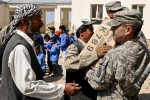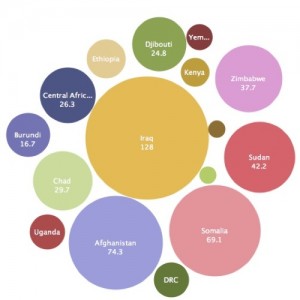 Moral crusaders would like to believe otherwise, but most people have a high tolerance for hypocrisy. Americans possibly even more so; the legal codes and policies of that country contain more contradictions than the Bible. Consider this doozy:
Moral crusaders would like to believe otherwise, but most people have a high tolerance for hypocrisy. Americans possibly even more so; the legal codes and policies of that country contain more contradictions than the Bible. Consider this doozy:
According to US law, nongovernmental human rights groups who meet with groups like Hamas can be prosecuted for providing material support to terrorists—even if the purpose of the meeting is to counsel terrorists against the use of violence.
The US government and its corporate partners in war can, however, provide a virtually unlimited amount of guns, ammo, tanks, fighter jets and tear gas to ruthless autocrats—and no one in America will face the slightest repercussion if and when those weapons are used against unarmed democratic protesters.
Jimmy Carter is a potential terrorist. “The Butcher”? He’s just another federal employee.
In a scathing post at her blog, Sibel Edmonds complains that “material support to dictators” is often misleadingly called “foreign aid.” She writes:
The majority of our people have this romantic notion of what’s called ‘US Foreign Aid.’ When they hear ‘US Foreign Aid,’ they picture hungry naked children with ribs showing, and bowls of Corn Flakes delivered to them by angelic faced men and women wearing bright colored t-shirts…with rolled up sleeves hammering away: building bridges, digging wells, paving roads…Helping poor nations put infrastructure in place or fight diseases…
Such reassuring pictures aside, the reality is most of what’s misleadingly called foreign aid money is military in nature, rather than humanitarian. And increasingly, the US military is employing servicemembers and contractors to build schools, distribute food and generally acting like it wants to put the State Department and the Peace Corps out of business.
Today, Oxfam published a new report that explores this trend in detail. Its conclusions are not positive. From the summary:
Since 2001 there has been a growing trend of aid being used to win “hearts and minds” in conflicts. Unfortunately, this aid is often poorly conceived, ineffective, and in some cases has turned beneficiaries and aid workers into targets for attack… This type of aid often by-passes the poorest people and dangerously blurs the line between civilian and military activity.
That line between civilian and military hasn’t merely blurred—it’s been erased. Oxfam reports that the budget for “aid” distributed at the discretion of US military commanders is now almost as large as the entire global budget for the civilian agency, USAID.
Naturally, most of that military-controlled “aid” is spent in countries under occupation.
Since 2002 one- third of all development aid to the 48 states labelled ‘fragile’ by the OECD has gone to just three countries: Iraq, Afghanistan and Pakistan. During this period aid to Iraq and Afghanistan alone has accounted for over two-fifths of the entire $178bn global increase in aid provided by wealthy countries.
 This chart compares the annual amount aid per capita from wealthy OECD donor countries to countries undergoing “comparably serious chronic humanitarian crises”—Iraq, Somalia, Sudan, etc.—from 2001 through 2008.
This chart compares the annual amount aid per capita from wealthy OECD donor countries to countries undergoing “comparably serious chronic humanitarian crises”—Iraq, Somalia, Sudan, etc.—from 2001 through 2008.
Worse, much of the military-humanitarian aid is what Oxfam calls “conditional.” A more accurate word is “coercive.” The aid is offered as a bribe in exchange for submission to US authority, or for information that will be used to kill American adversaries.
Oxfam quotes from leaflets distributed by US forces in southern Afghanistan, which said that “to continue the humanitarian aid,” locals must “pass on any information related to the Taliban, Al Qaeda and Gulbaddin.”
The message may as well be, Turn in your cousins who joined the Taliban, and we’ll replace the homes that we destroyed.
Although the venerable NGO is anything but blunt, Oxfam also faults the US military’s execution. The report offers an Afghan assessment on US military-led development projects, a perspective that’s always conspicuously absent from the Army’s photo-ops.
As Shamisullah, a teacher in Daikundi in central Afghanistan, told Oxfam: ‘Not even 5 per cent of our schools have buildings and many are far away from their homes. In Kandahar, they build many schools but what good does it do? It is too dangerous for girls to even go. [Here in] Daikundi, they would be full … But the international community does not care about us, they only care about Al Qaeda.’
And this:
High-profile, ‘quick impact’ projects to ‘stabilize’ violent districts have failed to provide sustainable solutions to humanitarian needs or poverty, as a tribal leader in Paktia explained: ‘we really do not need somebody to distribute biscuits to us and do not need construction projects that fall down after a year’…
Seriously? Who doesn’t need free cookies that were carried from around the world on a $120 million cargo plane?
On a positive note, military leaders appear to be listening to Afghan concerns about unnecessary snack deliveries to their villages. So, instead of cookies, the US military will be distributing assault rifles.
Sounds like a plan.
The Oxfam report was released to news organizations this week and held under embargo until today. I’ve posted a copy below.
Oxfam report on militarization of humanitarian aid
[gview file=“/images/2011/02/bp145-whose-aid-anyway-ENG-FINAL.pdf”]